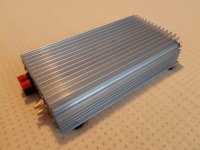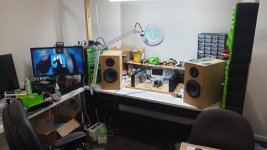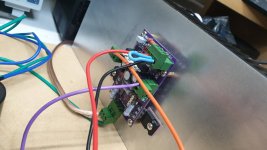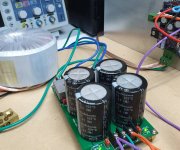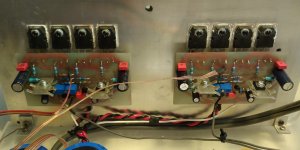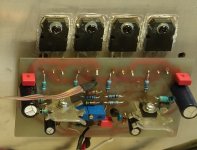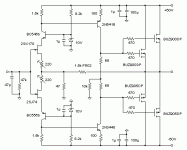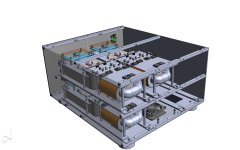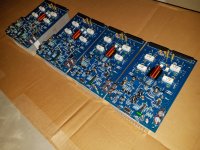Hi Frantisek,
Don't worry about your language being rough. Mine is worse so you are doing a lot better than I would be.
I was wondering if the copper traces on the circuit board could carry the high currents this design can deliver.
-Chris
Edit:
Thank you Max!
At times, when I want to beef up traces that I make on perfboards, or repair a damaged one, I lay a strip of de-soldering braid, then saturate it with solder along the strip.
That then can carry quite a few amperes if need be.
DUMMY LOAD
Not fully completed dummy load. Two independent sections. Big resistors are ARCOL 8R/200W, the others are from ebay, 4R/100W (do you see the difference ? ) I added two RCA monitor ports, one is raw output, the second one is attenuated by factor 30x (4x parallel 6k8/56R+protecting zeners).
Not fully completed dummy load. Two independent sections. Big resistors are ARCOL 8R/200W, the others are from ebay, 4R/100W (do you see the difference ? ) I added two RCA monitor ports, one is raw output, the second one is attenuated by factor 30x (4x parallel 6k8/56R+protecting zeners).
Attachments
very nice - looks very good - i also think about that + dividers - so thd and fft can be measured by the sound card - 1w, 5w, 10w, and 50 w
Seven years ago I did my first Mosquito amplifier for test, then I liked the sound and decided to try it again. The first time I had one pair of output laterals and a voltage of +/- 35V, now I made with two pairs and +/- 50V. I use 2SK1058 / J162 for output and 2SC2911 / A1209 for drivers.
The sound is good and I'll probably try how it sounds with other bipolar transistors or 2SK216 / J79 for drivers.
I have a modified JLH69 that sounds perfect . Mosquito has a completely different sound, not in the JLH69 class but a very good option for a good home amplifier.
For now, it promises.
The sound is good and I'll probably try how it sounds with other bipolar transistors or 2SK216 / J79 for drivers.
I have a modified JLH69 that sounds perfect . Mosquito has a completely different sound, not in the JLH69 class but a very good option for a good home amplifier.
For now, it promises.
Attachments
Attachments
All copper traces, for high currents, are well tin-plated and connected by 16A wires.
(rails, ground, power transistor collector / emitter and OUT).
The amplifiers have been working in my gym for nearly two months.
Usually only at 10-20% power 🙂
It's a home gym, not an ibiza disco 😀
The figure shows the power supply wires used (brown, blue).
Black and green-yellow was temporary 😉

This is really really nice. How are you going to attach it to the chassis / heatsinks
2x 330W/4R for my home gym 🙂

I ran a mobile disco for years with a stripboard amp inside.
This is really really nice. How are you going to attach it to the chassis / heatsinks
Thanks.
They are only laid on heatsink yet.
Amps work like this for two months in my gym 😀
Fasten them through the 4 + 4 holes on the prisms.
The beginning of my next huge class A mono blocks.
They will be Nelson pass class A mono blocks
drool
Very neat and beautiful on general purpose boards, Inko.
pl post pictures of the other/reverse side also.
pl post pictures of the other/reverse side also.
Thanks.
They are only laid on heatsink yet.
Amps work like this for two months in my gym 😀
Fasten them through the 4 + 4 holes on the prisms.
Looks great -NASA grade!All copper traces, for high currents, are well tin-plated and connected by 16A wires.
(rails, ground, power transistor collector / emitter and OUT).
The amplifiers have been working in my gym for nearly two months.
Usually only at 10-20% power 🙂
It's a home gym, not an ibiza disco 😀
The figure shows the power supply wires used (brown, blue).
Black and green-yellow was temporary 😉

100 watt retro amp based on 1980's Maplins 225WRMS disco amplifier.
Uses easy to find modern transistors.
The heat sink drilling is fun with TO3's. I used the pcb as a drilling template.
Uses easy to find modern transistors.
The heat sink drilling is fun with TO3's. I used the pcb as a drilling template.
An externally hosted image should be here but it was not working when we last tested it.
- Home
- Amplifiers
- Solid State
- Post your Solid State pics here

